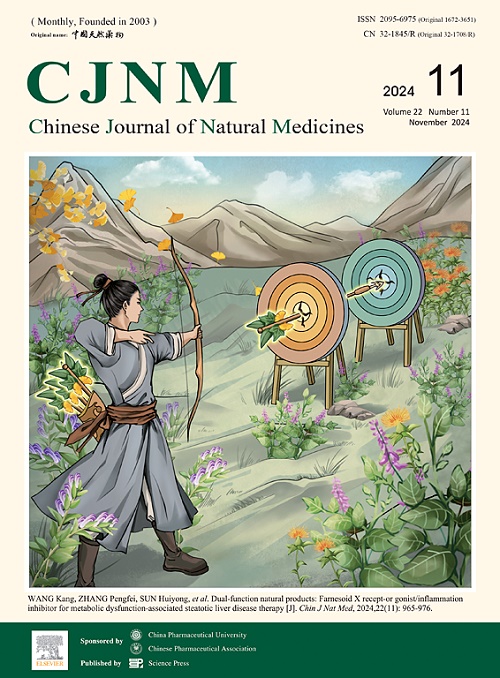Andrographolide sulfonate alleviates rheumatoid arthritis by inhibiting glycolysis-mediated activation of PI3K/AKT to restrain Th17 cell differentiation
IF 4.9
2区 医学
Q1 INTEGRATIVE & COMPLEMENTARY MEDICINE
引用次数: 0
Abstract
Andrographolide sulfonate (AS) is a sulfonated derivative of andrographolide extracted from Andrographis paniculata (Burm.f.) Nees, and has been approved for several decades in China. The present study aimed to investigate the novel therapeutic application and possible mechanisms of AS in the treatment of rheumatoid arthritis. Results indicated that administration of AS by injection or gavage significantly reduced the paw swelling, improved body weights, and attenuated pathological changes in joints of rats with adjuvant-induced arthritis. Additionally, the levels of tumor necrosis factor-alpha (TNF-α), interleukin-6 (IL-6), and IL-1β in the serum and ankle joints were reduced. Bioinformatics analysis, along with the spleen index and measurements of IL-17 and IL-10 levels, suggested a potential relationship between AS and Th17 cells under arthritic conditions. In vitro, AS was shown to block Th17 cell differentiation, as evidenced by the reduced percentages of CD4+ IL-17A+ T cells and decreased expression levels of RORγt, IL-17A, IL-17F, IL-21, and IL-22, without affecting the cell viability and apoptosis. This effect was attributed to the limited glycolysis, as indicated by metabolomics analysis, reduced glucose uptake, and pH measurements. Further investigation revealed that AS might bind to hexokinase2 (HK2) to down-regulate the protein levels of HK2 but not glyceraldehyde-3-phosphate dehydrogenase (GAPDH) or pyruvate kinase M2 (PKM2), and overexpression of HK2 reversed the inhibition of AS on Th17 cell differentiation. Furthermore, AS impaired the activation of phosphatidylinositol 3-kinase (PI3K)/protein kinase B (AKT) signals in vivo and in vitro, which was abolished by the addition of lactate. In conclusion, AS significantly improved adjuvant-induced arthritis (AIA) in rats by inhibiting glycolysis-mediated activation of PI3K/AKT to restrain Th17 cell differentiation.
穿心莲内酯磺酸盐通过抑制糖酵解介导的PI3K/AKT活化抑制Th17细胞分化来缓解类风湿关节炎
穿心莲内酯磺酸盐(AS)是从穿心莲中提取的穿心莲内酯的磺化衍生物。需要,并且在中国已经被批准了几十年。本研究旨在探讨AS在类风湿关节炎治疗中的新应用及其可能机制。结果表明,注射或灌胃给药AS可明显减轻佐剂性关节炎大鼠的足跖肿胀,改善体重,减轻关节病理改变。血清和踝关节中肿瘤坏死因子-α (TNF-α)、白细胞介素-6 (IL-6)、IL-1β水平降低。生物信息学分析以及脾脏指数和IL-17和IL-10水平的测量表明,关节炎条件下AS和Th17细胞之间存在潜在的关系。在体外,AS可阻断Th17细胞分化,CD4+ IL-17A+ T细胞百分比降低,RORγt、IL-17A、IL-17F、IL-21和IL-22表达水平降低,但不影响细胞活力和凋亡。正如代谢组学分析、葡萄糖摄取减少和pH测量所表明的那样,这种影响归因于糖酵解有限。进一步研究发现,AS可能与己糖激酶2 (HK2)结合下调HK2蛋白水平,而不下调甘油醛-3-磷酸脱氢酶(GAPDH)或丙酮酸激酶M2 (PKM2)蛋白水平,而HK2过表达逆转了AS对Th17细胞分化的抑制作用。此外,AS在体内和体外均破坏了磷脂酰肌醇3-激酶(PI3K)/蛋白激酶B (AKT)信号的激活,而添加乳酸可消除这一信号。综上所述,AS通过抑制糖酵解介导的PI3K/AKT的激活来抑制Th17细胞分化,从而显著改善大鼠佐剂性关节炎(AIA)。
本文章由计算机程序翻译,如有差异,请以英文原文为准。
求助全文
约1分钟内获得全文
求助全文
来源期刊

Chinese Journal of Natural Medicines
INTEGRATIVE & COMPLEMENTARY MEDICINE-PHARMACOLOGY & PHARMACY
CiteScore
7.50
自引率
4.30%
发文量
2235
期刊介绍:
The Chinese Journal of Natural Medicines (CJNM), founded and sponsored in May 2003 by China Pharmaceutical University and the Chinese Pharmaceutical Association, is devoted to communication among pharmaceutical and medical scientists interested in the advancement of Traditional Chinese Medicines (TCM). CJNM publishes articles relating to a broad spectrum of bioactive natural products, leading compounds and medicines derived from Traditional Chinese Medicines (TCM).
Topics covered by the journal are: Resources of Traditional Chinese Medicines; Interaction and complexity of prescription; Natural Products Chemistry (including structure modification, semi-and total synthesis, bio-transformation); Pharmacology of natural products and prescription (including pharmacokinetics and toxicology); Pharmaceutics and Analytical Methods of natural products.
 求助内容:
求助内容: 应助结果提醒方式:
应助结果提醒方式:


